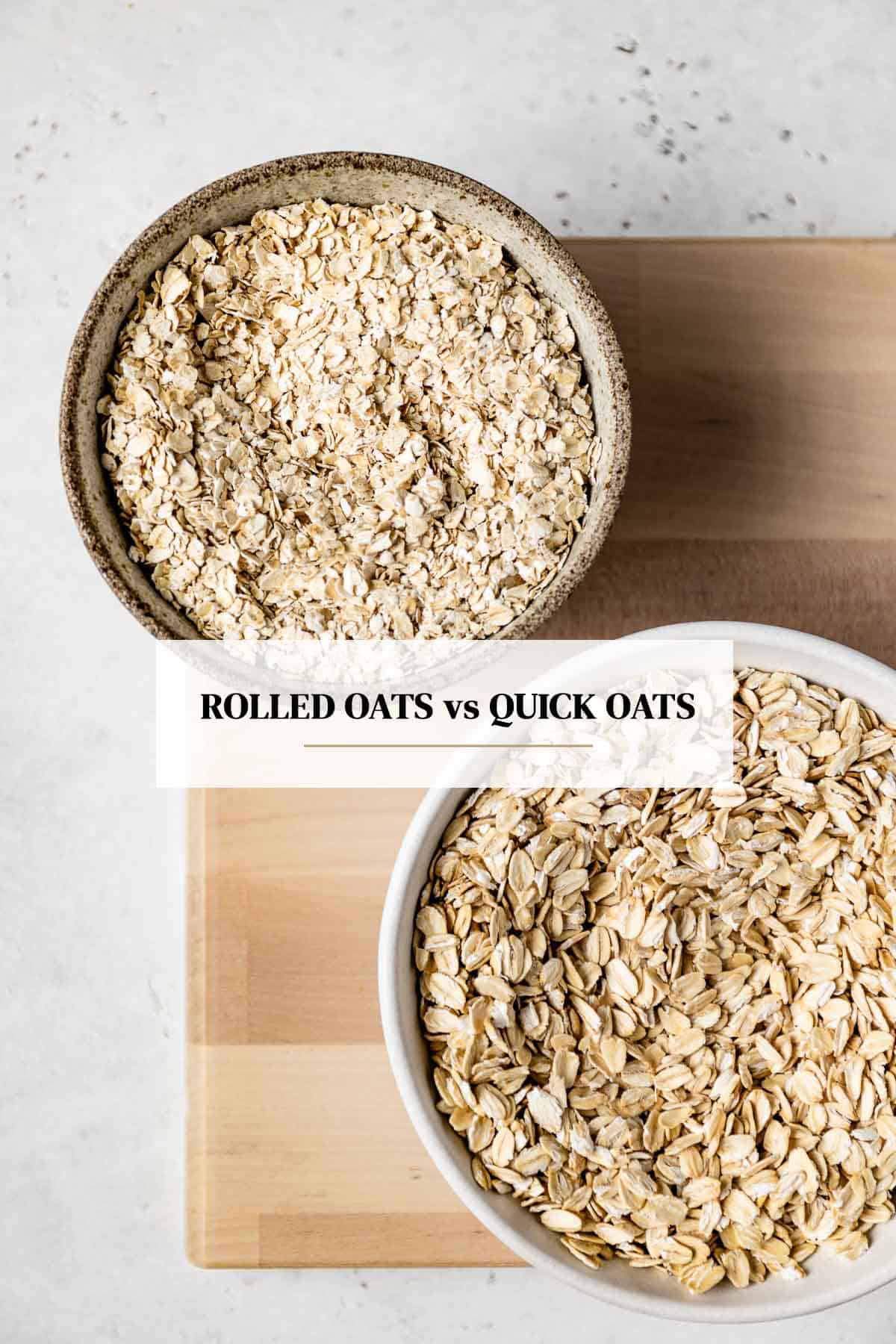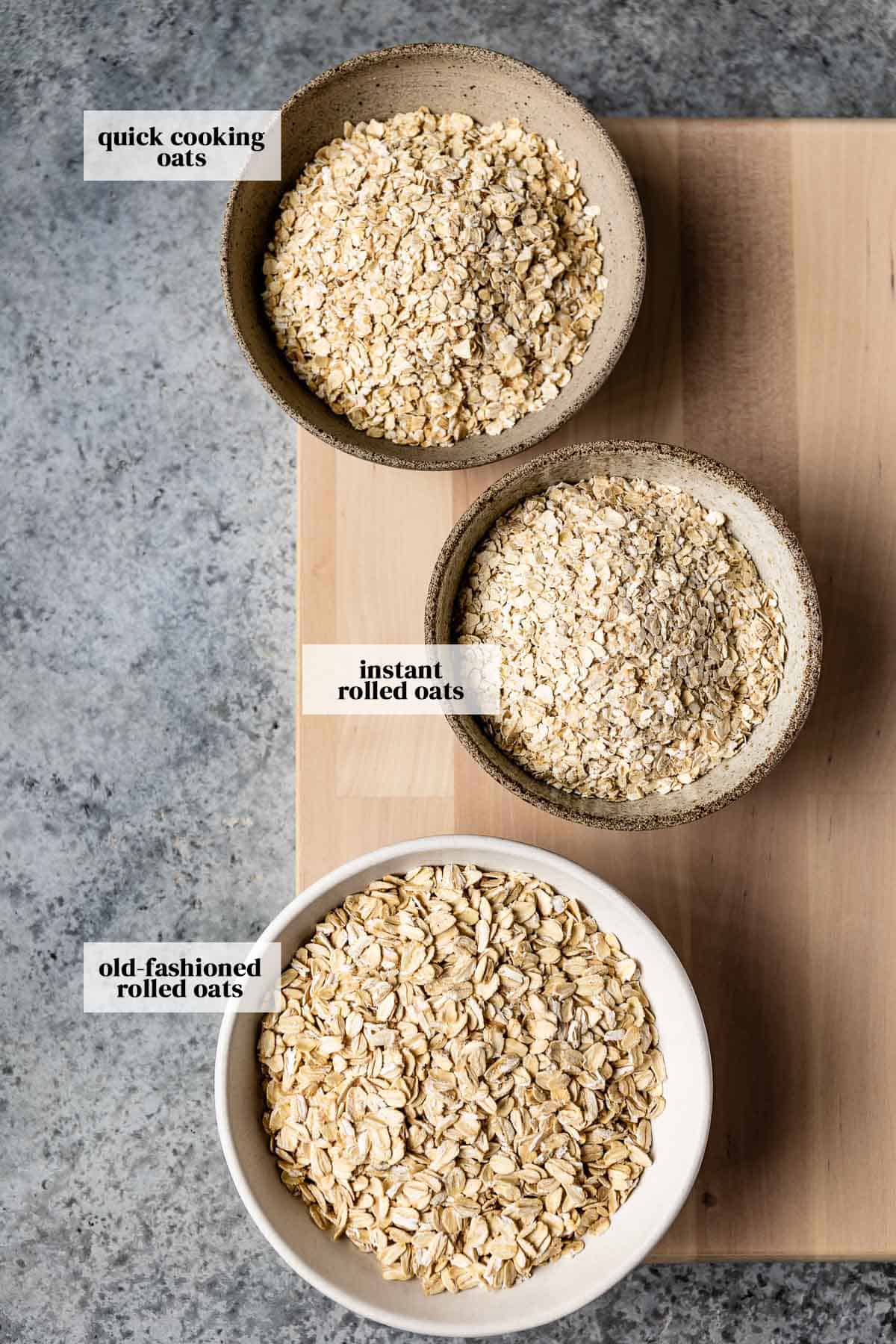And if you want to learn more about oats, check out Steel Cut Oats vs. Rolled Oats, too.
What are Rolled Oats, and How are They Made?
Regular Rolled Oats, also referred to as Old-Fashioned Oats, Regular Oats, and Large Flake Oats, start out as whole oat groats with their husks (outer shell) still intact. Once the husk is removed, the oats are steamed, then rolled flat with heavy steel rollers (hence the name rolled oats), and dried in a kiln (thermally insulated chamber). Thickness varies depending on brand and manufacturing, but the general process remains unchanged. The beauty of rolled oats is that the drying process contributes to their mild flavor and stabilizes the healthy oils in the grain by deactivating an enzyme that can cause the oats to spoil. This creates a longer shelf life, usually, about 6-9 months once opened, making them a staple pantry ingredient for many.
What are Quick Cooking Oats and How are They Made?
Quick Oats (Quick-Cooking Oats) start out just like rolled oats. They are the whole oat kernel with the husk intact. Once the husk is removed, the oat kernels are steamed for a longer period of time, then rolled thinner. The thin oat flakes are then cut into smaller pieces. The thinner and smaller oats create a greater surface area, resulting in less time on the stove.
Quick Oats vs. Instant Oats
Now, at this point, you might ask; Are quick-cooking oats and instant oats that I see on the shelves of my local grocery store the same? The answer is no. Instant Oats are not the same as quick oats. Instant oats take processing a step further. They are quick oats that are precooked, dried, and then cut into even smaller pieces. Instant Oats are ready to eat after a 1-minute soak in hot water or zap in the microwave. Additionally, most packaged instant oats brands sold in the markets today are geared toward people who are looking for a quick and easy breakfast. While there is nothing wrong with that, most of these individual-sized packaged instant oats are packed with sugars. So, it is best to read the ingredients label and decide whether or not it is the right option for you.
What is the Difference Between Rolled Oats and Quick Oats?
Rolled oats are steamed for a shorter period of time and rolled into larger, thicker flakes. Quick oats are steamed longer and rolled into thinner flakes, then cut into small pieces. Because quick cooking rolled oats have a greater surface area, they can absorb liquid more quickly, which makes for a faster cook time and a softer texture. Rolled oats take longer to fully cook and absorb liquid. Here are the differences in appearance, texture, and cook time broken down into a handy chart:
Nutritional Comparison
The nutritional value of quick-cook oats vs. rolled oats varies based on manufacturing. However, in general, both types of oats are nutritious whole grains that are high in antioxidants, fiber, vitamins, and minerals. According to Nutrition Value, here are their key nutrition facts broken down in the table below: Note: The nutritional values below are based on Bob’s Red Mills’ Rolled Oats and Quick Cooking Oats. Values will vary based on brand. As always, refer to your preferred nutrition calculator.
Old Fashioned Oats vs. Quick Oats Glycemic Index
According to the British Journal of Nutrition, researchers from Quaker Oats tested the Glycemic Index of 72 oat products. Based on their research, rolled oats have a glycemic index of 53, while quick-cooking rolled oats have a glycemic index of 71. If you are not familiar, the glycemic index measures how much a food spikes your blood sugar with a value between 0-55 being low, 56-69 being medium, and 70-100 being high. It appears that rolled oats have a lower glycemic index, and quick oats can raise your blood sugar quicker because of their smaller size. Keep in mind certain packages of quick oats also contain added sugars and salt. This will alter the nutrition information and glycemic index as well.
Can Old Fashioned Oats be Substituted for Quick Oats?
The answer truly depends on the recipe. Here are the best uses for rolled oats and quick oats, along with some substitution suggestions:
Uses of Rolled Oats: Rolled oats are incredibly versatile and can be used in so many different applications. Some of my favorites include Cinnamon Apple Oatmeal, Almond Milk Oatmeal, Baked Oatmeal with Dates, Homemade Granola, and 5-Ingredient Granola Bars.Uses of Quick Oats: Quick oats are smaller and cook faster, which alters the texture of many recipes. With that being said, if you don’t mind a few extra minutes of soaking time, you can get away with cooking them. I love to use quick oats in Homemade Muesli as quick oats quickly soften as soon as it interacts with liquid without having to cook them.Substituting: Generally speaking, you can use rolled oats and quick oats interchangeably in healthy breakfast recipes like regular oatmeal or porridge, smoothie recipes, baked goods like Healthy Oatmeal Raisin Cookies, Pumpkin Oatmeal Muffins or Oatmeal Cookies, or homemade oat flour (made by processing oats in a food processor until they are pulverized.)Overnight Oats: The only application where substituting quick oats for old-fashioned oats may not be the best idea is when making overnight oats with almond milk, Yogurt Overnight Oats, and Overnight Muesli, as quick oats break down too much and become too soggy. With that being said, in a pinch, you can use quick oats instead of regular oats in your favorite overnight oats recipe. The texture would be softer (and mushier), but it would still work.


